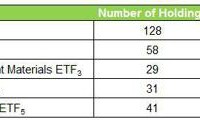Best And Worst Q1’16: Materials ETFs, Mutual Funds And Key Holdings
The Materials sector ranks fourth out of the ten sectors as detailed in our Q1’16 Sector Ratings for ETFs and Mutual Funds report. Last quarter , the Materials sector ranked seventh. It gets our Neutral rating, which is based on aggregation of ratings of nine ETFs and 15 mutual funds in the Materials sector. See a recap of our Q4’15 Sector Ratings here . Figure 1 ranks from best to worst the eight Materials ETFs that meet our liquidity standards and Figure 2 shows the five best and worst-rated Materials mutual funds. Not all Materials sector ETFs and mutual funds are created the same. The number of holdings varies widely (from 26 to 121). This variation creates drastically different investment implications and, therefore, ratings. Investors seeking exposure to the Materials sector should buy one of the Attractive-or-better rated ETFs or mutual funds from Figures 1 and 2. Figure 1: ETFs with the Best & Worst Ratings – Top 5 Click to enlarge * Best ETFs exclude ETFs with TNAs less than $100 million for inadequate liquidity. Sources: New Constructs, LLC and company filings The Fidelity MSCI Materials Index ETF (NYSEARCA: FMAT ) is excluded from Figure 1 because its total net assets are below $100 million and do not meet our liquidity minimums. Figure 2: Mutual Funds with the Best & Worst Ratings – Top 5 Click to enlarge * Best mutual funds exclude funds with TNAs less than $100 million for inadequate liquidity. Sources: New Constructs, LLC and company filings The iShares U.S. Basic Materials ETF (NYSEARCA: IYM ) is the top-rated Materials ETF and the Fidelity Select Materials Portfolio (MUTF: FMFEX ) is the top-rated Materials mutual fund. Both earn an Attractive rating. PowerShares S&P SmallCap Materials Portfolio (NASDAQ: PSCM ) is the worst-rated Materials ETF and the Rydex Basic Materials Fund (MUTF: RYBMX ) is the worst-rated Materials mutual fund. PSCM earns a Dangerous rating and RYBMX earns a Very Dangerous rating. 161 stocks of the 3000+ we cover are classified as Materials stocks. Monsanto Company (NYSE: MON ) is one of our favorite stocks held by IYM and earns an Attractive rating. Over the past decade, Monsanto has grown after-tax profit ( NOPAT ) by 16% compounded annually. Over this same time, the company has improved its return on invested capital ( ROIC ) from 7% to 14%. Despite the long-term profitability of the company, shares remain undervalued. At its current price of $88/share, Monsanto has a price to economic book value ( PEBV ) ratio of 1.1. This ratio means the market expects Monsanto’s profits to grow by only 10% over its remaining corporate life. If Monsanto can grow NOPAT by just 5% (under a third of historical rate) compounded annually for the next decade , shares are worth $140/share today – a 59% upside. Vulcan Materials (NYSE: VMC ) is one of our least favorite stocks held by Materials ETFs and mutual funds and earns a Dangerous rating. Vulcan Materials business has yet to recover from the global recession in 2008. Since 2007, the company’s economic earnings have fallen from -$88 million to -$463 million on a trailing twelve months basis. Over this same time, its ROIC has declined from 8% to a bottom quintile 3%. Despite the deterioration of the business, the stock trades at the same prices it did prior to the recession, which leaves it significantly overvalued. To justify its current price of $82/share, Vulcan must grow profits by 14% compounded annually for the next 25 years . This expectation is awfully optimistic given that since 1998, Vulcan’s NOPAT has actually declined by 1% compounded annually. Figures 3 and 4 show the rating landscape of all Materials ETFs and mutual funds. Figure 3: Separating the Best ETFs From the Worst ETFs Click to enlarge Sources: New Constructs, LLC and company filings Figure 4: Separating the Best Mutual Funds From the Worst Mutual Funds Click to enlarge Sources: New Constructs, LLC and company filings D isclosure: David Trainer and Kyle Guske II receive no compensation to write about any specific stock, sector or theme. Disclosure: I/we have no positions in any stocks mentioned, and no plans to initiate any positions within the next 72 hours. I wrote this article myself, and it expresses my own opinions. I am not receiving compensation for it. I have no business relationship with any company whose stock is mentioned in this article.
